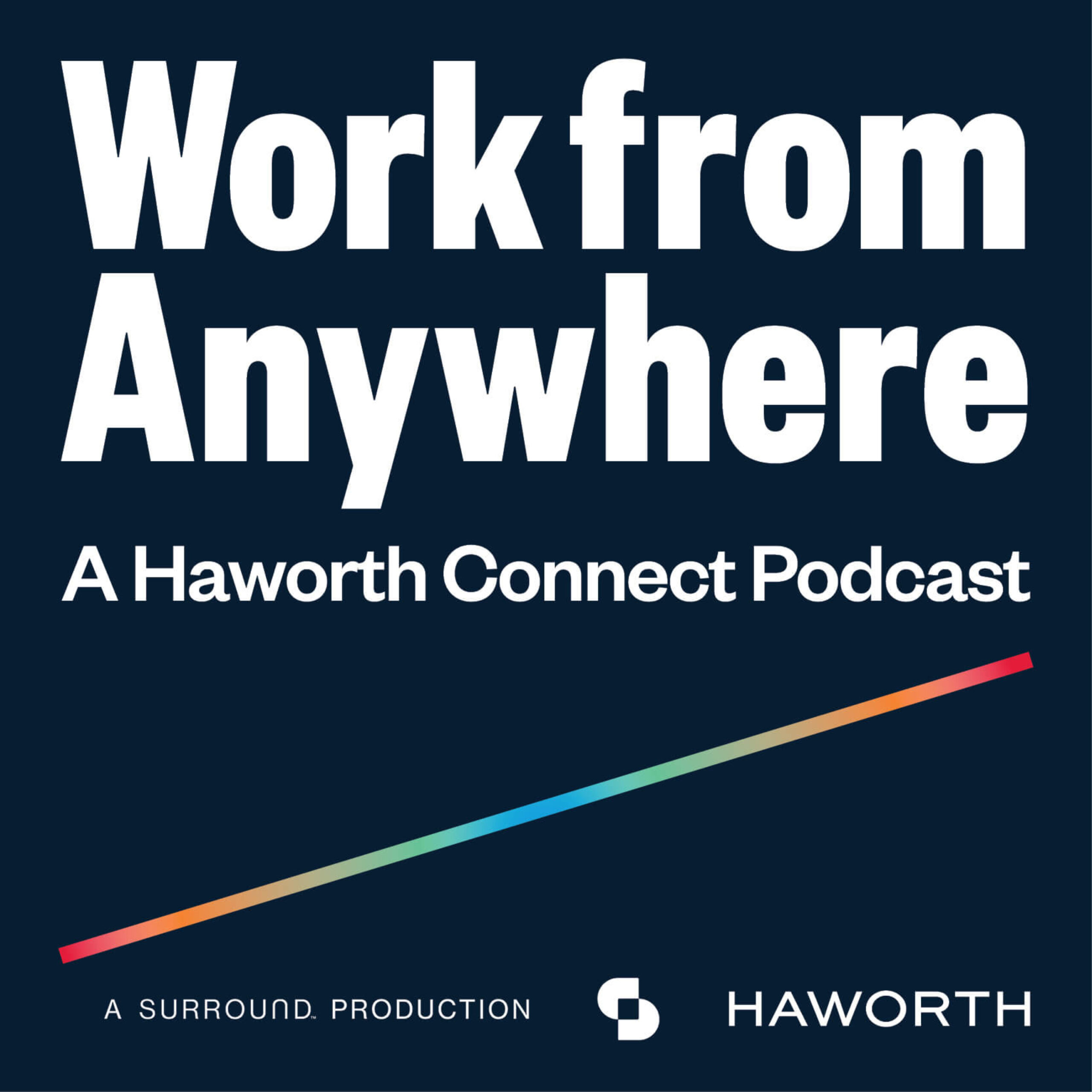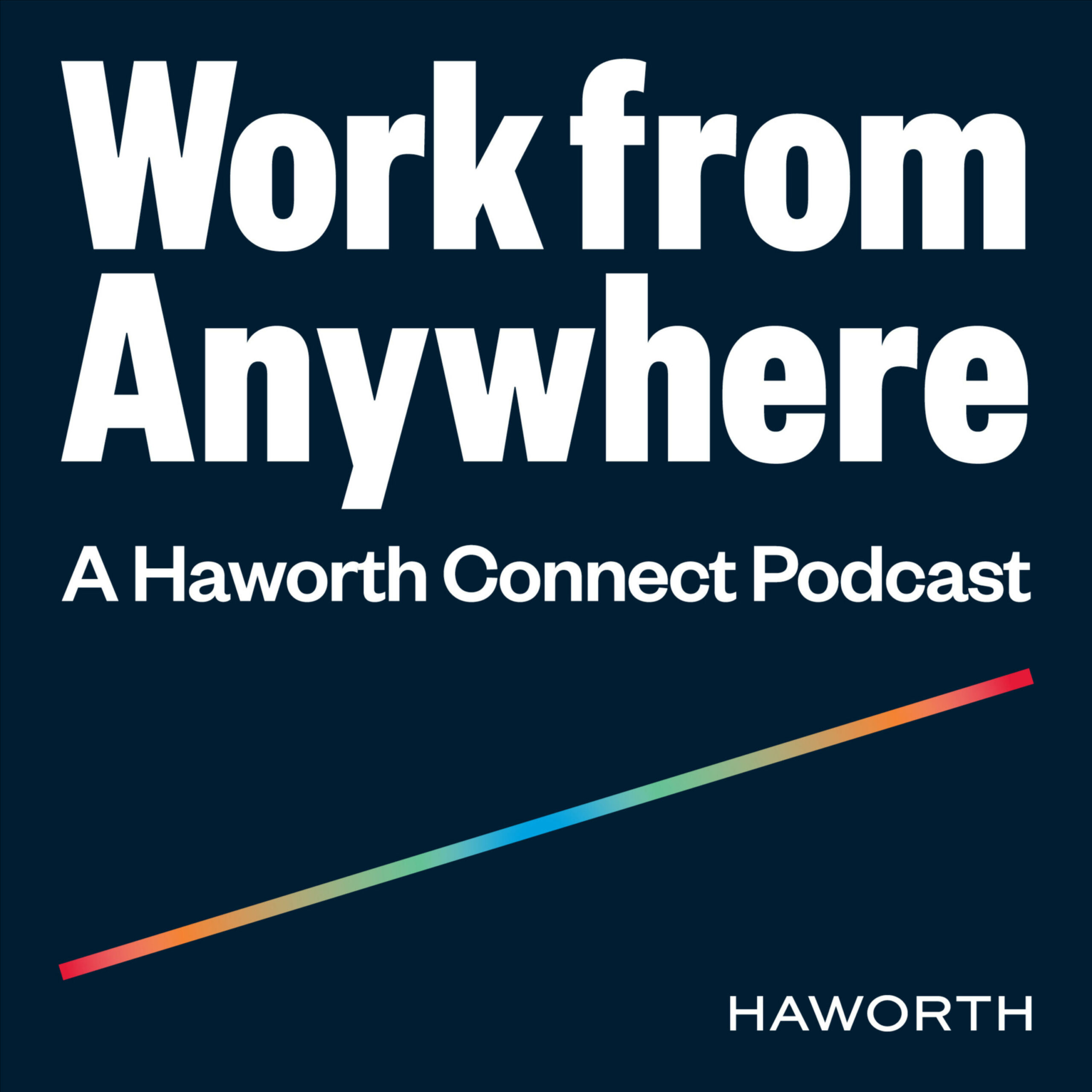Although the transcription is largely accurate it was generated in part by an automated service. In some cases it is incomplete or inaccurate due to inaudible passages or transcription errors.
Christine: Welcome to the Work From Anywhere Podcast. We are now kicking off Season 2.
In this series, we’ll focus on organizational culture and how important that is to the way we go forward in a work from anywhere ecosystem. With the office remaining the hub of this ecosystem, culture is the way that we really look at how we can support hybrid, how we can support the policies, and how we design the workplace to best support the most effective and efficient and engaged workforce.
I’m Christine Gritter, Corporate and Content Marketing Manager with Haworth, and today, I am here talking to John Scott, the Senior Workplace Design Strategist with Haworth, and we’re going to have a conversation around organizational culture and how that applies to workplace design.
John: Hi, Christine.
Christine: Welcome. I know you’re involved in a lot of projects with customers, and you talk to a lot of them as they’re going through this new journey of getting people back into the workplace, making sure that they’re supporting their workers the best.
What are you hearing? What’s top of mind of leaders as they’re looking at how to approach space and new policies in the organization?
John: That’s a big, big question. Leaders in a lot of organizations are trying to manage various facets of the organization. It’s the people, of course, the facility, and the organization itself. But really when it comes down to where we are today, it’s really: how do you maintain productivity. How do you ensure that you’re finding you’re striking the right balance of the hybrid workplace, of who’s coming in, trying to get more people back into the workplace, because productivity is still a very important component to a lot of organizations?
The other interesting facet to that is also how can they increase or create a better utilization of their real estate footprint. So, we have a lot of empty spaces right now, and that is keeping a lot of leaders up at night. How do I fill that space? Do I shed it? What do I do differently to balance both what we’re trying to do as an organization, but at the same time, trying to provide balance to our employees? So, I would say between those elements, there’s a big opportunity there that still exists that many leaders are still trying to get their heads wrapped around.
Christine: So balancing the needs of the organization with the desires, wants, and pull of the employees.
John: Correct.
Christine: Because without employees, without them being engaged and productive, the organization can’t move forward.
John: Right.
Christine: Is this new in the world of thinking? I feel like in the past, and some leaders now even are like, we’re here, this is what our organization does. Do you want to work here? You come in, right? But I feel like there’s a big movement now towards providing flexibility, employees who have proven themselves in the flexibility and want to be more independent. But how do you balance that with keeping that organization strong? What is the key to that?
John: I think it’s different for each organization, and certainly by different industry types. Some are going to have this idea around, we’re an office-first company. We need to be in-person the majority of the week in order for us to be successful. Other types of companies, other types of industries, are trying to figure out some sort of hybrid flexible work approach?
Whether it’s three days a week, two days, whatever, and then there’s others who are taking a step back and saying, we’re a remote-first organization and we’re reevaluating everything. It is about how we use space. Maybe we don’t need as much as we had in the past. Maybe we need to get rid of space.
Maybe we open satellite offices or leverage coworking spaces, but we’re taking a step back from what we did in the past. And so there’s a whole variety of what companies are doing and how they’re doing it. There’s not a secret sauce or a perfect formula here, which makes this such a challenging time.
It’s also an exciting time because we’re on the cusp of the unknown. We’re seeing the future unfold in front of us. And we’re trying to figure out how do we leverage what we have available to us, and yet still maintain all the important facets of an organization and supporting the employees.
And so at the foundation, at the core of that, I believe strongly that it’s all about organizational culture. It’s all about who you are as an organization, what you believe in, how you lead your employees. It’s how you define success, what you place as strategic initiatives, and all of that. We say it all the time, culture is the personality of an organization. It is the compass that leads a company forward into the future. Without a strong understanding of who you are today, it’s really difficult to know where one is going and how to measure how successful you might be, but also if your culture needs to shift or change into the future.
Without that foundation, it’s really hard to build a strong home. And culture is that foundation.
Christine: It’s interesting. We heard so much early on in the pandemic when people were all remote for the majority [of the time] that leaders’ biggest stress point was losing their culture. And now I’m hearing it’s around employee attraction and retention, which is interesting because you think that’s really a shift, but at the end of the day, wouldn’t you say that’s just a different way of looking at culture?
Because they have to attract and retain employees by communicating their culture, aligning what they’re saying and what they’re doing with their culture, and getting those employees in.
John: Communication is vital when it comes to building a strong culture. If you don’t have clear and transparent communication throughout the organization, it opens the door to uncertainty, to rumors, to a vague understanding of what the goal or what the initiatives are for that organization. So, that’s where there’s a breakdown, and that’s where people start to rethink their future with that organization. And so communication, I believe, is really key.
I talk about this a lot: It’s not just the what is important to the organization, but the why. Why is it important for us as an organization? Why is it important for your business unit? And then, ultimately, why is this important for you as the individual, as the employee of this organization?
Without having that level of communication and focus, it starts to unravel the thread of culture, and it breaks down trust. The community starts to crumble. The glue to all of that is good communication from leadership.
Christine: Right. Leadership. Culture starts with leadership. When you talk to leaders and you help them understand I mean, obviously, they’re leading the culture, they understand the culture.
I know we have a way that we help at Haworth. We have some tools. Tell me a little bit about that because there are ways that we help people give words to their culture and help communicate their culture, help understand it. Tell me a little bit about that tool.
John: We have a dynamic partnership with the competing values framework, and this is a business model that’s been around for well over 40 years, but what they have initially done is they have created and identified four specific culture types that exist in all companies. And most companies will express a dominant, sometimes even a secondary culture. But all four are necessary for organizations to be successful. So, each of these culture types has different characteristics. They’re led by different types of people with different initiatives, different focus, different values.
They’re all held together by different components of that culture, but each are equally important, and each provide value to the organization. The four that we talk about, it really starts with a culture that we call collaborate.
And collaborate is not just these words are our action verbs. For the cultures, but the collaborate culture type is all about doing things that last and so it’s about building relationships, building trust, building community. We sort of joke; they actually like one another. They will go out and celebrate Diane’s divorce and Bob’s new kitten. It’s all about how can we do things that together we can embrace and support the human dynamic.
This culture is unique in of itself but there’s an interesting competing value to collaborate, which on the opposite end of the spectrum is what we call compete. So compete is all about doing things now. So it’s speed, results, acquisitions, profits, outpacing the competition. They love the spirit of competition.
Understanding this dynamic is really based on speed. One wants to move quickly to see short term performance wins and the others are wanting to ensure they have group consensus and long-term development of the human capital.
The other interesting dynamic is the next two culture types. We have one called control, which is sometimes also called hierarchy, but control is all about doing things the right way.
There’s a process in place. There are standard operating procedures. They love agendas. They are all about doing things consistently, reliably, and very safely for the organization and the employees. So they’re taking small incremental steps to reduce risk for the organization. And so they take calculated risks, but in a way that they can measure and then move forward.
And then, finally, the opposite end of that scale is what we call create. Create is all about doing new things. It’s about looking at new opportunities, looking at the future to say, what if, and why not? And let’s experiment, and test new opportunities, new prototypes, and they will take risks and expand upon it and try new things.
The element of risk is an important one between creating control, because create actually gets out of their comfort zone to explore the unknown where control likes to take the necessary steps in a very safe way to ensure that everyone is operating within the parameters of safety and organizational structure.
These four culture types are uniquely different, and uniquely important, but they are all necessary. And within those company cultures, interestingly enough, you can have subcultures within an organization. So you can have a company like, manufacturing typically tends to be a very red control, but within that control culture type, you can have different business units that are all expressing the behaviors and cultures of collaborate, create, and compete.
It’s interesting enough knowing just not only how the organization operates, how it performs, how it sort of guides itself along its journey, but within that, you have these pockets of subcultures that also provide interesting and very valuable contributions to that organization.
Christine: So that’s just very interesting that you think about this as overall culture. That leadership is leading. They’re making decisions through the lens of that culture. So that’s back to your point on communication. The key is to their communicating why they’re making the decisions and how they’re making the decisions. But I’m imagining with each of these cultures, even if they’re subcultures or overall cultures, there’s always a different motivation for why people want to be back in the office.
Obviously, we keep hearing the office is the place of collaboration. So, for the collaborate culture, that seems to fit right in. But everyone has a way and a reason they want to be back in, and a need. For innovation to move forward, for understanding, for certain meetings and certain interactions that just can’t happen virtually.
How does that really manifest itself when looking at the cultures?
John: It is really interesting to think about the why behind the return to the workplace for each culture type. I believe that each of these culture types needs a sense of connection to one another. And so if it’s a collaborate culture type, that is, oftentimes they see themselves almost like a second family. They share meals, go bowling together, and they’ve missed that connection while we’ve been separated.
So, having that connection in person and being able to share stories and connect with one another. It’s so much easier to do in person for this culture.
We’re a compete culture because speed is of the essence, and they are working against the clock to, to outpace their competition and meet that deadline. Sometimes, you need to have people next to you in order to have quick conversations, gather information quickly, make decisions quickly. It’s easier again to do that when you are in person.
A control culture, they’re monitoring and coordinating and measuring and managing people and projects. It’s easy to do that when you are together in person. You can see and react and find the best path forward when you are together.
And then the create side of things. Yes, it can be done virtually, but the best most important impactful brainstorming opportunities happen in person because there’s opportunities.
There are times where in, in divergent thinking, we have what’s called a flash of insight with the, the aha moment, the flash bulb above one’s head that can occur when you’re together in person and it’s beautiful as it appears. And so having the ability to be together to bounce ideas off of one another to disagree, to discuss, and have that conversation is vital for a culture that’s trying to develop breakthrough innovative ideas.
I really believe that having that in-person connection in the office works really well for each of these culture types. Yes, they can be done virtually. It could take longer. The output, the quality, might not be as well as what it could be maybe in person.
Christine: So the spontaneity, the ability to connect, the ability to work.
Unstructured, almost, and spontaneous is the key for a lot of these different organizations. The spaces that they want to come back to also probably vary because it depends on how you want to work. But knowing that the office provides a different environment than anywhere else. There are probably different spaces that people are looking at right now.
And structuring the office a little differently.
John: Yeah, and that’s where culture plays such a vital role because understanding one’s culture, you can then translate that into the physical workplace. If you have a culture who is highly familiar with one another and wanting to spend a great amount of time with each other, you may want to have spaces that represent a neighborhood that have opportunities to have informal, spontaneous conversations where they can connect, relax, discuss, and build relationships. There are other areas where you may need to have project rooms or war rooms where teams can work quickly to pursue that opportunity to see that big win.
There are others where you need to have space to visually see a schedule of a project process, a map, Gantt charts, things that you can virtually or visually see in order to understand how that process is moving forward and if action needs to be taken and then spaces where you can brainstorm and build prototypes and have a model shop and build and break things and understand what works and what doesn’t work, and ideate through that process.
These are all spaces that are important for each of those culture types, and that’s where I think organizations could take a step further and not just try to change the workplace to attract more, but to make a purposeful effort to create the right intention in the workplace for the right culture types.
Christine: I mean, this is not new, you know, being able to design for culture is something, we’ve helped customers with for years. What’s interesting to me right now is there’s so much more focus on looking at the workplace through different lenses.
There’s so much uncertainty that’s come up on what is the future of the office, what is it going to look like, and so many organizations looking to change the way their office is organized, structured, and designed based on the idea that they want a space people want to come back to. I’m hearing things like it should not be a mandate, it should be a magnet for people.
You want spaces that support and make people feel like they’re doing their best work. The questions arise is how do I do that? And we’re learning, I mean through everything you’re saying, it’s not a one size fits all. But at least we’re giving them a place to start. At least there’s an idea. If you look at your culture first, you can help figure that out.
John: And it’s not free popcorn, right? Or free coffee. Amenities go only so far. While they’re important, I think it’s a small percentage of helping to bring people more in. It’s really, how do you earn that commute?
How do you provide value and purpose in coming in that day? Oftentimes, it’s looking at things like, do we have the right focus spaces because focus work still has to happen, you still need to have convergent thinking and concentrate on work you still need to have a variety of collaboration spaces both in person and still yet virtual collaboration that needs to take place.
So having the right technology in place, but then between that, you have to have the right types of relaxation spaces so that people can unplug when and if they need to. A big push right now is our organizations providing healthier food services. That’s a big component to bringing people into the workplace, and maybe expanding upon those hours—not just from 12 to 1 PM.
Maybe it’s an offering all day long with each day is different, different options. And then finally, what we’re hearing and seeing is still providing access to outdoor spaces is proven to be very important for employees when they come in. So, there’s a lot to consider. There’s a lot to, to provide and consider when, trying to build the right type of space.
But without first building that foundation of culture, the other fundamentals, might fall short.
Christine: If you have a structured organization who now has a ping pong table, people aren’t going to understand how to do that.
John: That’s not going to be received well.
It’s really understanding: What do these cultures need? How do they work? How are they going to use the environment to best support their work? And then looking at what other opportunities or amenities could we plug in to help provide a better overall experience? Because that’s really what it comes down to is, can we elevate the human experience while we are at work?
Yes, there are times where we might have to have anchor days during the week and work remotely or work from home. There might be days where we decide we’re not having any meetings on Wednesday so that we can actually get some work done because we’re inundated now with meetings and more meetings.
But there’s so many things to consider and so many amenities and whatnot. But if we first start and look at what’s important to those different business units and those different culture types within sometimes even getting down to, there are some generational differences that are also uniquely kind of important.
That’s another podcast series, but I think the idea is there’s so much to consider that, again, there’s not a perfect formula that will work for everyone. And that’s what makes this exciting is every opportunity is unique and different and important. So, it’s first understanding what are your goals, what are your objectives for the future?
And then, how do we get you there? So that’s what we work hard to do is, is first listen, but then also try to map out and strategize and build a process or a map moving forward to get you to your arrival.
Christine: Thank you. That makes a lot of sense. I’m excited because I think we’re on the cusp of a change in what’s going on and the focus on the employee experience tied to culture, different than just creating a space that’s now called work, but looking at how we actually do work.
So, I’m kind of excited about that.
John: Good. Me too.
Christine: Thanks for being with us today, John.
John: Well, thanks for having me, Christine.
Christine: We hope you enjoyed our insightful conversation as much as we did. If you’re looking to learn more, please subscribe or like this podcast. We’re available wherever you find your podcast, and we will be continuing this series on organizational culture, talking to people within Haworth and outside Haworth to explore and learn more, and we hope you’ll learn along with us.







